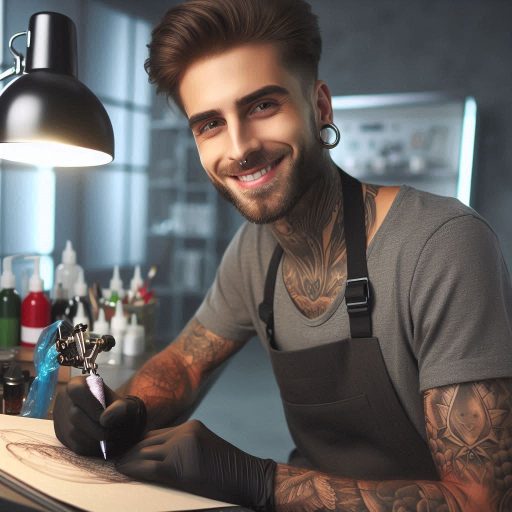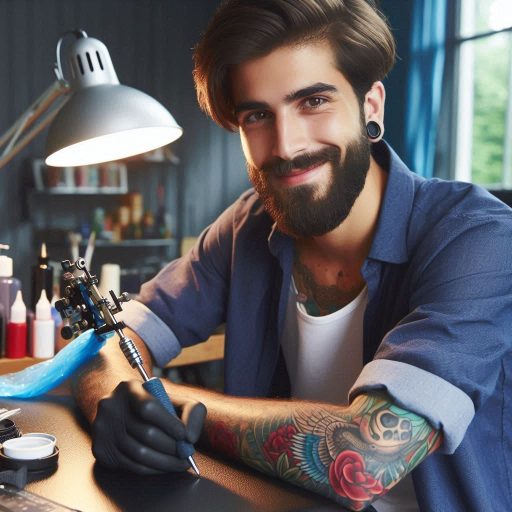Introduction
Tattoo art has a rich history that dates back thousands of years.
Ancient cultures, from the Egyptians to the Polynesians, used tattoos for various purposes.
They often symbolized status, bravery, or spiritual beliefs.
However, tattoos were once considered taboo in many societies, associated with rebellion or criminality.
Over the years, societal views on tattoos have dramatically changed.
In the late 20th century, tattoos began to gain acceptance as a form of personal expression.
Today, they are celebrated in popular culture and embraced by people of all backgrounds.
Celebrities, athletes, and influencers proudly display their ink, further normalizing tattoo art.
Understanding the tattoo creation process is essential for anyone considering getting one.
It helps individuals make informed choices about design, placement, and artist selection.
Knowing the steps involved can enhance appreciation for this art form.
From brainstorming concepts to the actual inking, every phase plays a vital role in the final outcome.
Moreover, understanding the process fosters respect for tattoo artists and their craft. Tattooing requires skill, precision, and creativity.
By acknowledging the effort behind each piece, clients can cultivate a deeper connection to their chosen artwork.
Embracing the journey from concept to completion enriches the tattoo experience, turning it into a meaningful and memorable milestone.
Choosing a Design
When it comes to getting a tattoo, the design you choose is perhaps the most important decision you’ll make.
Your tattoo will be with you for life, so it’s essential to select a design that truly resonates with you.
Here are some key points to consider when choosing a design:
Importance of Selecting a Meaningful Design
Choosing a tattoo that is meaningful to you can make the entire tattoo process more fulfilling.
Whether it’s a symbol that represents your values, a quote that inspires you, or an image that reminds you of a special memory, a meaningful tattoo design can have significant emotional impact.
Transform Your Career Today
Unlock a personalized career strategy that drives real results. Get tailored advice and a roadmap designed just for you.
Start NowSources of Inspiration for Tattoo Designs
There are countless sources of inspiration for tattoo designs.
Cultural symbols, such as Celtic knots, Japanese flowers, or Maori patterns, can add depth and complexity to your tattoo.
Personal experiences, like travel adventures or life milestones, can also serve as inspiration for a unique design that reflects your journey.
Size, Placement, and Style of the Tattoo Design
Consider the size, placement, and style of the tattoo design to ensure that it complements your body and reflects your personality.
Large, intricate designs may be better suited for areas with more space, like the back or thigh, while smaller, simpler designs may work well on the wrist or ankle.
Think about whether you want a black-and-white or color tattoo, as well as the overall aesthetic you’re going for.
Ultimately, the best tattoo design is one that speaks to you on a personal level and brings you joy every time you see it.
Take your time exploring different options and consult with a professional tattoo artist to bring your vision to life.
Read: Freelance vs. In-House Event Design Jobs
Finding the Right Tattoo Artist
When it comes to getting a tattoo, finding the right tattoo artist is crucial.
The artist you choose will be responsible for turning your ideas into a permanent piece of art on your body.
Here are some steps to help you find the perfect tattoo artist for your needs.
Research Local Tattoo Artists and Their Portfolios
Start by researching the tattoo artists in your area.
Look at their portfolios to get a sense of their style and expertise.
Pay attention to the quality of their work and see if it aligns with the vision you have for your tattoo.
Take the time to explore different artists and find one whose work resonates with you.
Consider Factors Such as Experience, Style, and Reputation
When choosing a tattoo artist, consider factors such as their experience, style, and reputation.
Look for an artist who has been in the industry for a significant amount of time and has a strong portfolio to back up their skills.
Consider whether their style matches the aesthetic you are going for with your tattoo.
Additionally, look for reviews and recommendations from past clients to get a sense of the artist’s reputation.
Transform Your Career Today
Unlock a personalized career strategy that drives real results. Get tailored advice and a roadmap designed just for you.
Start NowSchedule Consultations with Potential Tattoo Artists
Once you have narrowed down your list of potential tattoo artists, schedule consultations with each of them.
During these consultations, discuss your ideas and concepts for your tattoo.
This is also a great opportunity to see if you and the artist are a good fit.
Communication is key when working with a tattoo artist, so make sure you feel comfortable with them and that they understand your vision for the tattoo.
Finding the right tattoo artist is an important part of the tattoo process.
By taking the time to research, consider different factors, and schedule consultations, you can ensure that you find an artist who will bring your tattoo ideas to life in the best possible way.
Remember, your tattoo is a permanent addition to your body, so it’s essential to choose an artist who will create a piece that you will be proud to wear for years to come.
Read: Understanding Tattoo Inks: Types and Safety Tips
Design Consultation
During the design consultation, you will have the opportunity to sit down with your tattoo artist to discuss your vision.
This is a crucial step in the tattoo process as it allows you to communicate your ideas and preferences directly to the artist.
Meeting with the tattoo artist
The first step in the design consultation is meeting with the tattoo artist to share your ideas.
This is your chance to talk about the concept you have in mind and any specific details you want to incorporate.
The artist will listen carefully to your ideas and offer their professional input based on their expertise and experience.
Collaborate with the artist
Once you have shared your ideas, the artist will collaborate with you to bring your vision to life.
The artist may suggest adjustments to the design to ensure that it will work well as a tattoo.
It is important to be open to feedback and work together with the artist to create a design that you will be happy with.
Finalize details
After collaborating with the artist, you will finalize details such as the size, color, and placement of the tattoo.
The artist will work with you to ensure that the design fits well on the chosen placement on your body.
It is important to take the time to discuss and agree on these details before moving forward with the tattoo.
In fact, the design consultation is a critical part of the tattoo process.
Transform Your Career Today
Unlock a personalized career strategy that drives real results. Get tailored advice and a roadmap designed just for you.
Start NowIt allows you to work closely with the artist to create a design that reflects your vision and meets your expectations.
By communicating openly and collaborating with the artist, you can ensure that the final tattoo will be something you love and are proud to wear.
Preparing for the Tattoo Session
When it comes to getting a tattoo, proper preparation is key to ensuring a successful and satisfying experience.
Here are some important aspects to consider before you step into the tattoo studio:
Importance of Properly Preparing Your Skin
- Cleanliness is crucial for the healing process, so make sure your skin is free of any lotions or oils.
- Stay hydrated by drinking plenty of water in the days leading up to your appointment.
- Avoid sun exposure, as sunburned or damaged skin can be more sensitive and might not hold ink as well.
- If you have any existing skin conditions or allergies, inform your tattoo artist beforehand to prevent any complications.
Factors to Consider Before Getting a Tattoo
- Understand your pain tolerance level, as getting a tattoo can be uncomfortable for some individuals.
- Research potential risks associated with tattoos, such as infections or allergic reactions, and make an informed decision.
- Think about the placement of your tattoo to ensure it fits your lifestyle and career requirements.
- Consider the permanence of tattoos and how they may impact your future choices and opportunities.
Tips for Managing Anxiety and Discomfort
- Practice deep breathing exercises to help relax your mind and body during the tattoo session.
- Listen to music or podcasts to distract yourself from the discomfort and anxiety of getting tattooed.
- Communicate openly with your tattoo artist about any concerns or fears you may have before starting the session.
Remember to stay calm and focus on the end result, as the temporary discomfort will be worth it for your desired tattoo.
Read: Essential Tattoo Equipment for Aspiring Artists

The Tattooing Process
Steps involved in creating a tattoo
Creating a tattoo involves multiple steps that require precision and skill.
From preparing the skin to outlining the design, shading, and coloring, each phase contributes to the final masterpiece.
- Preparing the Skin: Before beginning the tattoo, the artist must clean and sterilize the skin to prevent infections.
This step is crucial to ensure the client’s safety and the longevity of the tattoo. - Outlining the Design: Using a stencil or freehand technique, the artist outlines the design on the skin.
This serves as a guide for the rest of the tattooing process, ensuring accuracy and symmetry. - Shading and Coloring: Once the outline is complete, the artist starts shading and coloring the tattoo.
This step requires attention to detail and expertise to achieve the desired depth and dimension in the design.
Equipment used during the tattooing process
The tattoo machine is the primary tool used in the tattooing process.
It consists of a needle that delivers pigment into the skin, creating the desired design.
- Tattoo Machine: Modern tattoo machines are equipped with adjustable settings to control speed and needle depth, allowing for precise and customized results.
- Needles: Different needle configurations are used for various tattooing techniques, such as lining, shading, and coloring.
Sterile, single-use needles are essential to prevent cross-contamination.
Importance of cleanliness and proper hygiene during the tattoo session
Maintaining proper hygiene during the tattoo session is crucial to prevent infections and ensure the client’s well-being.
The artist should follow strict protocols to sterilize equipment and maintain a clean working environment.
In general, the tattooing process is a meticulous and intricate art form that requires skill, creativity, and attention to detail.
By following proper procedures and using high-quality equipment, tattoo artists can create stunning works of art that clients can proudly wear for a lifetime.
Read: Top Event Design Trends in the United States
Delve into the Subject: Building a Strong Portfolio as an Art Director
Aftercare Instructions
When it comes to caring for your new tattoo, proper aftercare is crucial to ensure it heals correctly and looks its best in the long run.
Here are some key aftercare instructions to follow:
Keep it Clean
One of the most important things you can do to promote healing is to keep your tattoo clean.
Gently wash the tattoo with mild soap and water, being careful not to scrub too hard.
Transform Your Career Today
Unlock a personalized career strategy that drives real results. Get tailored advice and a roadmap designed just for you.
Start NowPat it dry with a clean towel.
Moisturize Regularly
After washing, apply a thin layer of fragrance-free, gentle moisturizer to keep the tattoo hydrated.
Avoid using products with harsh chemicals or fragrances that could irritate the skin.
Avoid Soaking
While it’s essential to keep your tattoo clean, you should avoid soaking it in water, such as swimming pools, hot tubs, or baths, until it is fully healed.
Prolonged exposure to water can slow down the healing process.
Protect from Sun Exposure
Direct sunlight can fade and damage your tattoo, so it’s important to protect it from UV rays.
Apply a broad-spectrum sunscreen with an SPF of at least 30 to the tattooed area whenever it will be exposed to the sun.
Watch for Signs of Infection
During the healing process, keep an eye out for any signs of infection, such as excessive redness, swelling, pain, or oozing pus.
If you notice any of these symptoms, contact your tattoo artist or a healthcare professional immediately.
Follow Any Additional Instructions
Depending on the size and location of your tattoo, your tattoo artist may provide specific aftercare instructions for you to follow.
Make sure to adhere to these guidelines to promote proper healing.
Be Patient
Healing times can vary depending on the individual and the tattoo’s size and location.
Be patient and allow your body to heal naturally.
Avoid picking at scabs or peeling skin, as this can damage the tattoo and prolong the healing process.
By following these aftercare instructions and practicing proper tattoo care, you can help ensure that your new tattoo heals correctly and looks vibrant for years to come.
Remember, taking care of your tattoo is an essential part of the tattoo art journey from concept to completion.
Touch-Ups and Maintenance
After getting a tattoo, it’s important to schedule touch-up appointments to maintain its appearance.
Touch-ups help keep the tattoo looking fresh and vibrant.
Importance of Scheduling Touch-Up Appointments
Touch-up appointments are crucial as tattoos tend to fade over time due to factors like sun exposure, skin shedding, and aging.
By scheduling touch-up sessions, you can enhance the longevity of your tattoo and keep the design sharp and vivid.
Transform Your Career Today
Unlock a personalized career strategy that drives real results. Get tailored advice and a roadmap designed just for you.
Start NowTouch-ups also allow the tattoo artist to fix any imperfections that may have occurred during the healing process or due to the natural wear and tear that tattoos experience over time.
Tips for Maintaining the Vibrancy and Longevity of the Tattoo
- Keep your tattoo moisturized with a high-quality, unscented lotion to prevent it from drying out and losing its vibrancy.
- Avoid exposing your tattoo to direct sunlight for prolonged periods as UV rays can cause the ink to fade faster.
- Avoid swimming in chlorinated pools or soaking in hot tubs as chlorine and chemicals can dull the colors of your tattoo.
- Avoid picking or scratching at scabs during the healing process to prevent color loss and scarring.
- Eat a healthy diet rich in vitamins and minerals to promote skin health and enhance the appearance of your tattoo.
Role of Sunscreen in Protecting Tattoos from Fading
Sunscreen is essential for protecting your tattoo from fading and maintaining its vibrant colors.
UV rays can cause the ink pigments to break down, leading to premature fading and dullness of the tattoo.
It is recommended to apply a broad-spectrum sunscreen with a high SPF (30 or above) to the tattooed area whenever you are going to be exposed to the sun for an extended period.
Reapply sunscreen every 2 hours or after swimming or sweating to ensure maximum protection.
Choosing a sunscreen that is fragrance-free and suitable for sensitive skin will help prevent irritation or allergic reactions that could affect the appearance of your tattoo.
By following these tips and scheduling regular touch-up appointments, you can ensure that your tattoo remains vibrant and beautiful for years to come.
Conclusion
The process of tattoo art involves several key steps from conceptualization to completion.
It is essential to have a clear idea of what you want before seeking out a tattoo artist.
Researching different styles and artists can help you find the perfect match for your vision.
Understanding the tattoo art process is crucial for ensuring that your tattoo turns out exactly how you imagined it.
Communication with your tattoo artist is key, as they will work with you to bring your concept to life.
It is important to carefully consider all aspects of getting a tattoo before making a decision.
Remember that tattoos are permanent, so take the time to choose a design that is meaningful to you.
By understanding the tattoo art process from concept to completion, you can ensure that you end up with a tattoo that you will be proud to wear for years to come.
Therefore, before getting inked, make sure to do your research, choose a skilled tattoo artist, and carefully consider all aspects of the process.
A well-thought-out tattoo will be a lasting piece of art that you can enjoy for a lifetime.
Take your time, weigh your options, and most importantly, make sure you are comfortable and confident in your decision.
Getting a tattoo is a personal experience, and by understanding the process, you can make informed choices that will result in a tattoo you will love.




